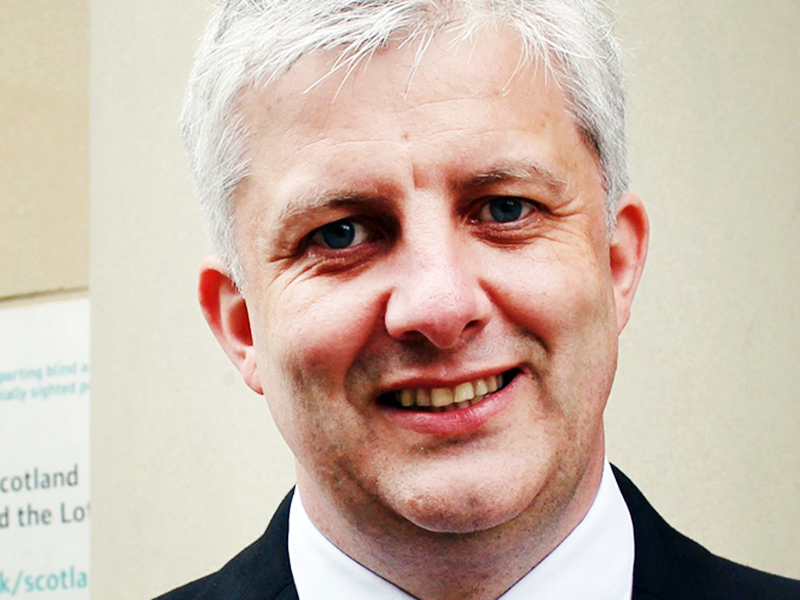The explosion on the technology curve over recent years has transformed society, and that change is only accelerating says James Adams of RNIB Scotland
The magnitude of emerging technology to empower individuals within society is immense, and its potential to remove barriers for people with sight loss presents a real opportunity.
An increasing focus within the technology sector is also to integrate with the UN Sustainable Development Goals (SDGs), ensuring accessible technology and inclusive design are embedded in service delivery.
Inclusive Design for Sustainability – the conference which RNIB Scotland is hosting this week – will bring together global technology companies, SMEs, academics, government, third sector and blind and partially sighted people to bring focus to the opportunity for technology to increase equity in society.
The key to ensuring that our society is accessible for everyone is to make the building blocks of infrastructure – from train stations, to schools, to streetscapes and the digital environment – appropriate for everyone. The way to achieve this is to ensure that accessibility needs are considered and built in at the design phase – ensuring that the infrastructure in society, digital or physical – is inclusive of everyone.
The challenges that people with sight loss face on a daily basis can be considerable: the lack of accessible educational material for children and young people with a visual impairment; to the transition into adulthood where often consideration of accessibility is not given priority; to the traveller trying to keep track of the latest changes in bus or train times and the gamer hoping to play the latest version of a block buster game along with everyone else.
Society needs to continue to focus on ensuring, at the design phase of everything, that the considerations for people with disabilities are central.
In recent times, there have been some welcome advances, For instance, the Scottish Parliament passed ground breaking legislation in providing inclusive communications on request for people needing information about their Scottish disability benefit entitlements. We have also seen welcome legislation in other areas – such as the priority given to the use of British Sign Language.
However, technology still holds the key.
As the provision of services in society, both public and private, is becoming increasingly digital we must ensure that inclusive design remains at the heart of every design process.
Increasingly, bank statements, communications from providers, access to entertainment are all going digital. For someone with sight loss, an online form can be as useless as a paper one if the technology does not enable them to use it. People with sight loss can engage in this brave new digital world but those developing the technology and applying new technology to the design of digital society must continually give consideration.
An early innovation on the internet was back in 2003 when RNIB set up RNIB Connect Radio, which has programming that is aimed at the wider interests of people with sight loss. This was a step into the new digital world, then unknown as to how people with sight loss would respond and engage with a medium that is internet based.
Now, as they approach the 20th anniversary, the station is going from strength to strength with a regular listenership of 100,000 and is growing. This shows the considerable desire that is there for content and application of technology from the visually impaired community.
As we speed through the 21st century, the global challenges that face us manifest themselves as increasingly local. No street or neighbourhood is untouched by the impacts of climate change and the economic, social and political dynamics that are all around us. The evolution of society and the way it meets these challenges also changes localities. For people with sight loss, this fast-moving environment also brings the risk of creating additional barriers, but technology can be a large part of the solution.
This is why within the UN SDGs there is a clear determination that the implementation of the goals is integrated with the needs of people with disabilities. Goal 4 specifies that there must be an ‘inclusive and equitable quality education’ for everyone, and that educational building and facilities must be inclusive. Likewise, in Goal 8 relating to the promotion of sustainable economic growth, states that it must be inclusive so those with disabilities are able to participate in society and have the opportunity to engage with the job market.
The SDGs underpin our collective desire globally to create a fair and more equitable world – and to do that government, civic society and the technology sector have a critical role to play.
We are looking forward to the two days of the Inclusive Design for Sustainability conference as it presents a real opportunity for the needs of people with sight loss in society to be the centre piece of the global conversation. We look forward to hearing from Axel Leblois from the Global Initiative for Inclusive Technologies, Christopher Patnoe, head of accessibility and disability for Google, and Diana Stentoft of the World Blind Union alongside many of the extraordinary innovative emerging tech companies that are developing tech solutions for people with sight loss.
The impact of advancements in technology for blind and partially sighted people cannot be understated. New developments will improve lives, allowing those with sight loss to gain confidence and independence.
By all working together and seeking to develop and apply Inclusive Design principles to meet the needs of people with sight loss we can contribute to making the world a better, fairer and more equitable place for future generations.
To find out more about the conference, which takes place in Glasgow on June 21 and 22, please visit rnib.org.uk/inclusivedesign
James Adams is director of RNIB Scotland, which works on behalf of those with sight loss.







